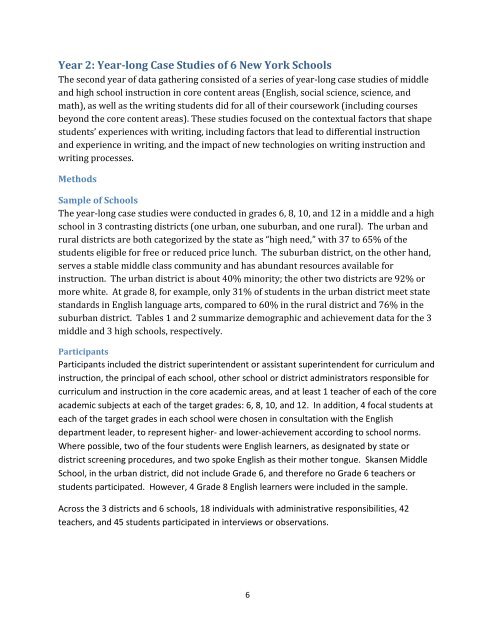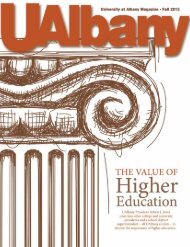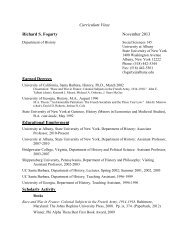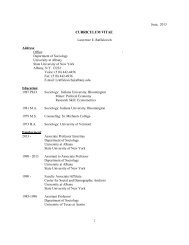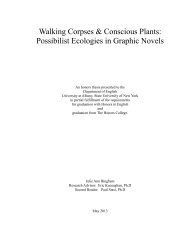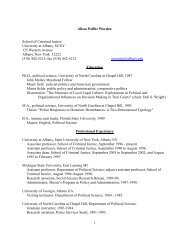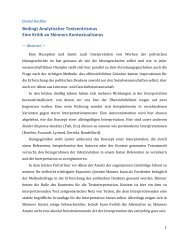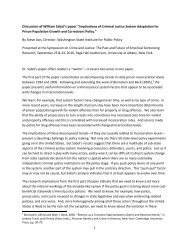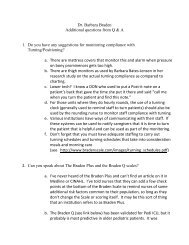The National Study of Writing Instruction - University at Albany
The National Study of Writing Instruction - University at Albany
The National Study of Writing Instruction - University at Albany
Create successful ePaper yourself
Turn your PDF publications into a flip-book with our unique Google optimized e-Paper software.
Year 2: Year-long Case Studies <strong>of</strong> 6 New York Schools<br />
<strong>The</strong> second year <strong>of</strong> d<strong>at</strong>a g<strong>at</strong>hering consisted <strong>of</strong> a series <strong>of</strong> year-long case studies <strong>of</strong> middle<br />
and high school instruction in core content areas (English, social science, science, and<br />
m<strong>at</strong>h), as well as the writing students did for all <strong>of</strong> their coursework (including courses<br />
beyond the core content areas). <strong>The</strong>se studies focused on the contextual factors th<strong>at</strong> shape<br />
students’ experiences with writing, including factors th<strong>at</strong> lead to differential instruction<br />
and experience in writing, and the impact <strong>of</strong> new technologies on writing instruction and<br />
writing processes.<br />
Methods<br />
Sample <strong>of</strong> Schools<br />
<strong>The</strong> year-long case studies were conducted in grades 6, 8, 10, and 12 in a middle and a high<br />
school in 3 contrasting districts (one urban, one suburban, and one rural). <strong>The</strong> urban and<br />
rural districts are both c<strong>at</strong>egorized by the st<strong>at</strong>e as “high need,” with 37 to 65% <strong>of</strong> the<br />
students eligible for free or reduced price lunch. <strong>The</strong> suburban district, on the other hand,<br />
serves a stable middle class community and has abundant resources available for<br />
instruction. <strong>The</strong> urban district is about 40% minority; the other two districts are 92% or<br />
more white. At grade 8, for example, only 31% <strong>of</strong> students in the urban district meet st<strong>at</strong>e<br />
standards in English language arts, compared to 60% in the rural district and 76% in the<br />
suburban district. Tables 1 and 2 summarize demographic and achievement d<strong>at</strong>a for the 3<br />
middle and 3 high schools, respectively.<br />
Participants<br />
Participants included the district superintendent or assistant superintendent for curriculum and<br />
instruction, the principal <strong>of</strong> each school, other school or district administr<strong>at</strong>ors responsible for<br />
curriculum and instruction in the core academic areas, and <strong>at</strong> least 1 teacher <strong>of</strong> each <strong>of</strong> the core<br />
academic subjects <strong>at</strong> each <strong>of</strong> the target grades: 6, 8, 10, and 12. In addition, 4 focal students <strong>at</strong><br />
each <strong>of</strong> the target grades in each school were chosen in consult<strong>at</strong>ion with the English<br />
department leader, to represent higher- and lower-achievement according to school norms.<br />
Where possible, two <strong>of</strong> the four students were English learners, as design<strong>at</strong>ed by st<strong>at</strong>e or<br />
district screening procedures, and two spoke English as their mother tongue. Skansen Middle<br />
School, in the urban district, did not include Grade 6, and therefore no Grade 6 teachers or<br />
students particip<strong>at</strong>ed. However, 4 Grade 8 English learners were included in the sample.<br />
Across the 3 districts and 6 schools, 18 individuals with administr<strong>at</strong>ive responsibilities, 42<br />
teachers, and 45 students particip<strong>at</strong>ed in interviews or observ<strong>at</strong>ions.<br />
6


